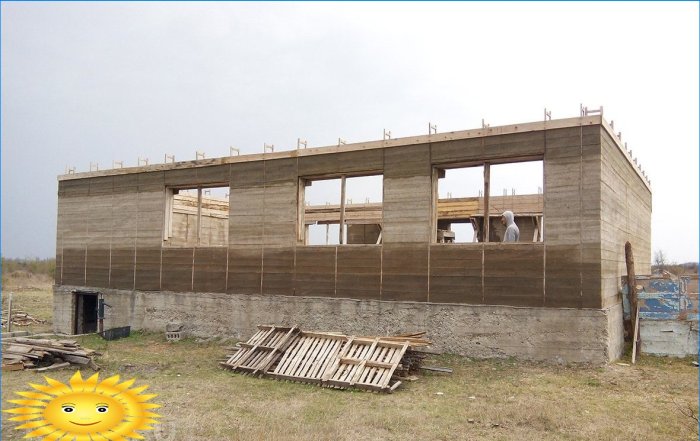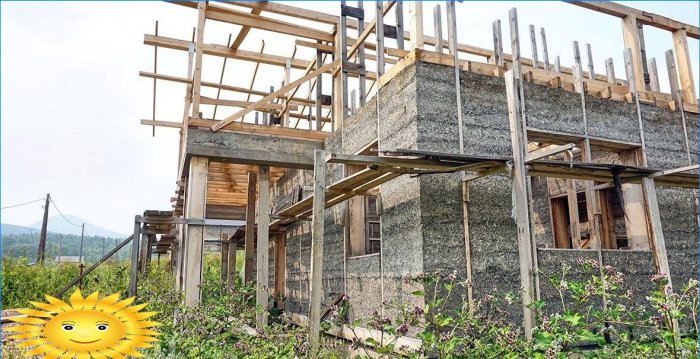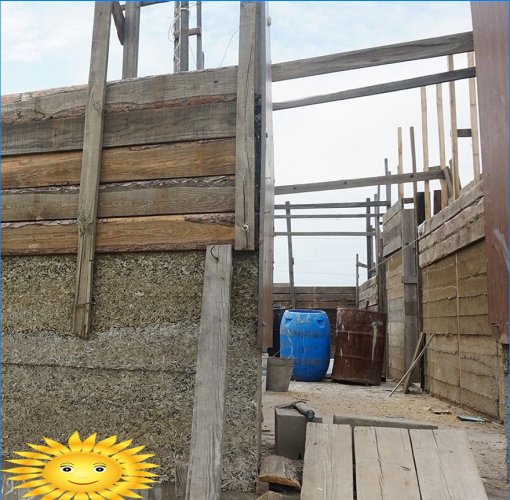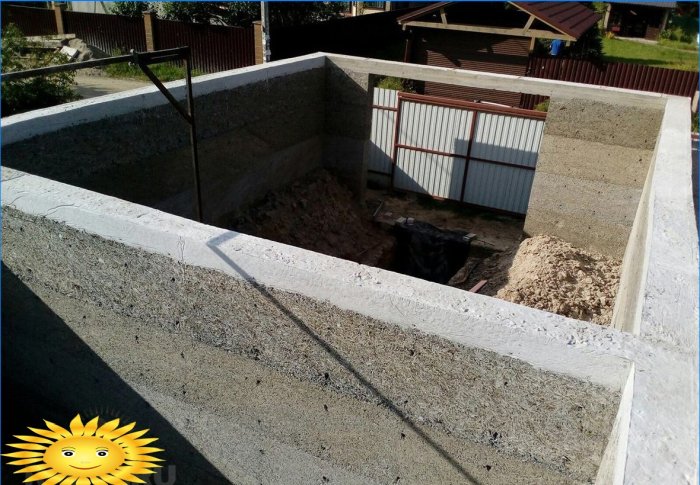The construction of energy-efficient and environmentally friendly houses from wood concrete is of interest to many. In this article, Our site of advice will tell you about the technology for the construction of private houses using arbonite. This technology has its advantages and disadvantages, you need to know about some tricks and pitfalls.
The portal has already written about arbolite more than once. We described the pros and cons of this material, the process of erecting walls, the features of the masonry of wood concrete. However, all the articles mostly concerned the use of blocks. Now let’s talk about monolithic arbolite, the walls of which are built by pouring a solution.
Recall that wood concrete is lightweight concrete, which consists of 85–90% wood chips. The material combines the best qualities of wood and high quality concrete. It is light, does not burn, does not rot, it is durable, it creates a microclimate in the house like in a log house. And most importantly, wood concrete has excellent thermal insulating properties, which makes it energy efficient at home..
The material created in the USSR back in the middle of the last century was originally called cement-bonded composite, and in the West it was called woodstone. Many buildings built from wood concrete 50 years ago are still in use without any signs of destruction..
Monolithic wood concrete has an important advantage over blocks made of this material – the wall is solid, there are no cold bridges due to interlayer seams. Accordingly, the house or outbuilding will be warmer. However, as construction specialists note, the process of erecting walls from monolithic wood concrete is more complicated than laying finished factory blocks. It is necessary to strictly adhere to the technology, monitor the quality of the poured solution. In addition, there are strict requirements for the formwork, which in this case is simply necessary..
There are two options:
- Use removable formwork. For example, from wooden shields. In this case, the walls of arbonolite will need to be plastered with a layer at least 3 centimeters thick outside the building and 1 centimeter inside..
- Use permanent formwork. For example, chipboards. Outside, they can then be closed with siding. Often houses are built like this – the outer layer is brick, and a finished wall is obtained that does not need finishing. From the inside – the formwork, and between them – a monolithic wood concrete. This technology allows you to get strong, monolithic walls inside, and outside – brick, which does not need to be protected from climatic influences.
The process of pouring monolithic wood concrete is complicated by the fact that this is not an ordinary solution! No other concrete will literally lie on a hill. Cement-sand mortars on water fill well the voids between the formwork. But the wood concrete contains wood chips from pine and spruce up to 40x10x5 millimeters in size. Moreover, this is the main material, cement and water serve only as a binder. And it is very difficult to tamp such a solution, the chips of the void will not fill themselves.
As a result, the process turns out to be longer than laying finished wood concrete blocks. It is necessary to pour a layer 30-40 centimeters high around the perimeter and tamp it very carefully.
Mixing the solution looks like this:
You can’t do without a concrete mixer. Liquid glass is added to the solution as a mineralizer to convert the sugar residues that are in wood chips into water-insoluble ones. Otherwise, water-soluble sugars will interfere with the setting of the concrete. Liquid glass can be replaced with aluminum sulfate or calcium chloride.
The process of gradually pouring arbonolite walls is very time consuming. You need a lot of solution, it is poured around the perimeter. Removable formwork gradually moves, rises, fixed formwork is completed. As the height of the walls grows, it is necessary to raise the buckets of mortar higher and higher, and this is physically very difficult.
Important! Experts advise to build walls from monolithic wood concrete with a thickness of at least 40, and preferably 60 centimeters, so that the house is energy efficient. The density of walls made of this material will be 350-400 kg / m3. In this case, the thermal conductivity will not exceed 0.075 W / (m · ° C). It is significantly warmer than foam concrete and gas silicate.
After pouring a layer of armoarbolite and tamping it, experts recommend putting a surcharge on it in order to achieve the maximum possible density and the solution solidified under pressure. Many home craftsmen, after finishing work, simply walk with their feet over the entire layer, additionally tamping it.
If the next layer is poured the next day, the upper uncured residues must be removed and re-added to the solution.
Important! Under the ceilings, mauerlat, along the plinth, in the openings in the walls, a reinforced belt is made of arbonolite.
Regarding what is cheaper – ready-made factory wood concrete blocks or a home-made monolith – there are disputes. If you get chips for free, for example, at the nearest sawmill, you can save money. However, the cement must be of the highest quality possible, mineralizers must be added, which also cost money. In addition, good quality formwork is needed. In general, an arbonolite house cannot be called economical and cheap. Warm and durable – yes, which draws the owners’ attention to this difficult and time-consuming construction technology.
According to the reviews of home craftsmen who built houses using this technology on their own, for pouring a solution with a volume of up to 75 m3 it takes a month.
Arbomonolite: features of the technology of building houses
Arbomonolite is a cutting-edge technology that offers immense advantages to builders and homeowners alike. This advanced solution utilizes the strength of concrete and composite materials to create durable and lightweight structures. It's a resource-efficient and eco-friendly alternative to conventional building techniques, offering superior fire-proofing, noise reduction, and energy efficiency. Furthermore, its streamlined production processes minimize the need for costly heavy machinery, so it's an affordable and practical solution for construction projects. Arbomonolite's versatility, strength, and sustainability are key reasons why it's becoming the preferred choice for modern, efficient construction today.
Construction Materials






What are the key features of the Arbomonolite technology for building houses?
What are the key features and benefits of the Arbomonolite technology in building houses, and how does it differ from traditional construction methods?